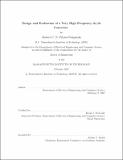Design and evaluation of a very high frequency dc/dc converter
Author(s)
Pilawa-Podgurski, Robert C. N
DownloadFull printable version (2.354Mb)
Other Contributors
Massachusetts Institute of Technology. Dept. of Electrical Engineering and Computer Science.
Advisor
David J. Perreault.
Terms of use
Metadata
Show full item recordAbstract
This thesis presents a resonant boost topology suitable for very high frequency (VHF, 30-300 MHz) dc-dc power conversion. The proposed design is a fixed frequency, fixed duty ratio resonant converter featuring low device stress, high efficiency over a wide load range, and excellent transient performance. A 110 MHz, 23 W experimental converter has been built and evaluated. The input voltage range is 8-16 V (14.4 V nominal), and the selectable output voltage is between 22-34 V (33 V nominal). The converter achieves higher than 87% efficiency at nominal input and output voltages, and maintains efficiency above 80% for loads as small as 5% of full load. Furthermore, efficiency is high over the input and output voltage range. In addition, a resonant gate drive scheme suitable for VHF operation is presented, which provides rapid startup and low-loss operation. The converter regulates the output using high-bandwidth on-off hysteretic control, which enables fast transient response and efficient light load operation. The low energy storage requirements of the converter allow the use of coreless inductors, thereby eliminating magnetic core loss and introducing the possibility of integration. The target application of the converter is the automotive industry, but the design presented here can be used in a broad range of applications where size, cost, and weight are important, as well as high efficiency and fast transient response.
Description
Thesis (M. Eng.)--Massachusetts Institute of Technology, Dept. of Electrical Engineering and Computer Science, 2007. This electronic version was submitted by the student author. The certified thesis is available in the Institute Archives and Special Collections. Includes bibliographical references (p. 139-143).
Date issued
2007Department
Massachusetts Institute of Technology. Department of Electrical Engineering and Computer SciencePublisher
Massachusetts Institute of Technology
Keywords
Electrical Engineering and Computer Science.